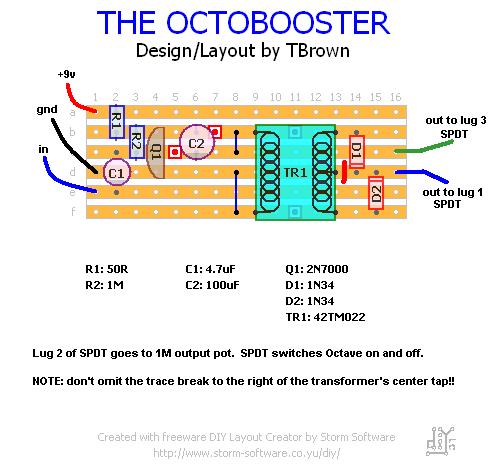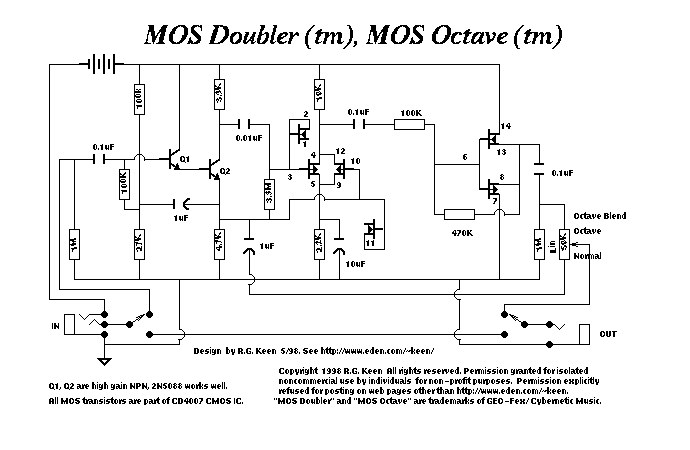Reverb w shimmer (effectively)... reverb w/ clean oct up in fb loop.. questions
|
Hey All,
I've been reading this forum for a while a just finally started building boxes. Finished a Zendrive and Prunes&Custard using the veros on this site and I wanted to first extend a thank-you to you all.. this has been an incredible resource for me. You guys inspire me, really.. I don't see a schematic for a reverb w/ shimmer (clean octave up, blendable ideally), so I figured the easiest way to create one would be to use a reverb with a feedback loop, and to throw a clean octave up (as clean as possible) into the loop. I could house everything in one enclosure and add a blend knob into the feedback loop... even add a stomp to toggle on/off the feedback loop. What is the best clean octave-up circuit you guys know of? I found this on DIYStompboxes and it seemed to have good reviews... I don't have an x-former to try it out, was hoping a few of you guys had experience with clean octave up. ..it doesn't need to be super clean, and I wouldn't mind if it was a bit glitchy like the whammy 4s octave up.. but something clean enough so that when you blended a fair amount of octave into the clean reverb that it still sounds like a reverb rather than sounding like a bitcrushed, distorted reverb with intermittent octave (though maybe that would sound good too?) Any input would be super appreciated... even input on your favorite reverbs with available veros. Thanks for reading!.. and I look forward to becoming a contributing member of this community. 
|
|
i'm sure wiser heads here than i can advise you re cleanest analog octave ups, but you might want to look at some of the escobedo circuit snippets for octave up/down circuits to get some ideas for an analog shimmer experiment. a lot of good roots for circuit ideas concentrated in one place there.
i only use analog octave ups and downs for fuzzes as they tend to track pretty roughly, which sounds good-bad in a dirty fuzz way. but for a classic clean shimmer it needs to track pretty tightly to sound shimmer and not shudder. i'm broke so i try to build everthing that i can't buy a solid cheap clone of, but for all my searching couldn't find an analog shimmer worthy of the name and had to bite the bullet and buy a digital verb with shimmer (hardwire supernatural) to get one that sounded perfect to me. the behringer reverb machine is something worth considering too if you are on a budget. but for cleans analog tends to strangle and mangle octaves very quickly. even if you build something that works nicely in the middle frets, it may shatter above the tenth or below the fifth fret. you can get that nice 'iron lung' glitchy octave up with a few things, but shimmer suits an octave that is a bit more stable. if you really want to build, the stanley fx goldmine reverb and shimmer is a digital analog combination design for which all the schematics and digital code has been made freely downloadable by the maker over at fsb. it requires that you, or someone you know (or can bribe), can programme a dsp chip with the code, but if you can get that far then everything you need to make it has been made available (a generous offer, since he sells them too). re the octave fuzzes, the foxx tone machine (easily-modded joyo voodoo octave is a straight metal box clone) has the cleanest octave up of my octave fuzzes. maybe you can isolate the octave section from the fuzz and use that? schematic is everywhere and it uses all common parts (no inductors, etc). i would be interested to see what you come up with re an analog shimmer design. you might not get what you want but you might still end up with something must-have for having attempted it. |
|
Thanks for the reply.
After scouring the internet for a while I found this.. I've read that this is a fairly clean octave up. I guess it accomplishes this by CMOS instead of full-wave rectification type octaves. Anyone familiar with this design?   I'm inexperienced in creating veros from schematics.. anyone know of an existing vero for this circuit? OR anyone wanna take the time to create one?!?! =))) Thanks all |
Re: Reverb w shimmer (effectively)... reverb w/ clean oct up in fb loop.. questions
|
I'm just thinking Freppo could tell you an easy way to do octave with CMOS inverters. He knows all about that kind of thing.
Through all the worry and pain we move on
|
|
that would be great.. paging Dr. Freppo?
I was thinking too about the ways octave-up tracking can be improved, even with fuzzy octave circuits. I could add a controllable low-pass filter of some kind into the feedback loop to remove all the complex harmonics from the signal that the octave up will effect... and I should be able to isolate that removal from the rest of the circuit (the reverb)... so only the octave sounds will be filtered. That should work, right? I'm not sure how much effect that will have on cleaning up the octave sounds, but it should only improve it, not hurt it I would think. I don't have a ton of experience with CMOS, either unfortunately. Will do some reading today. |
|
This post was updated on .
hey notnews,
freppo (fredrik lyxzen) is on of the upcoming superheros of the diy pedal universe. definitely one to watch if you want to know learn something worth learning. the contributions section here and his blog are full of his original designs if you want to check out his work. he juggles running his own blog (http://www.parasitstudio.se/) with his visits and contributions here, so you may want to visit his site in case he has already posted something there that may be useful to you. his recent 'how to get into cmos' guide is in three parts here: http://www.parasitstudio.se/building-blog/cmos-workshop-part-1 http://www.parasitstudio.se/building-blog/cmos-workshop-part-2-square-wave-fuzz http://www.parasitstudio.se/building-blog/cmos-workshop-part-3-octave-down third part is octave down, which may suit your needs and intentions. he's also about to release a new design which may be of particular interest to you. "I'm working on a new circuit - a guitar synth pedal. Now really sure exactly what to call it yet... It does one or two octaves down and one or two (!) octaves up at the same time What makes this special is that the octave up part is based on a frequency controlled oscillator so it doesn't scramble chords like usual octave circuit and it tracks well over the entire fretboard. Compared to the Arcadiator it sounds less like a fuzz and more like a pure synth. It can be very controlled, but also make superglitchy sounds." http://www.parasitstudio.se/building-blog/new-original-in-the-works your reading list just got longer. |
«
Return to Requests
|
1 view|%1 views
| Free forum by Nabble | Edit this page |

